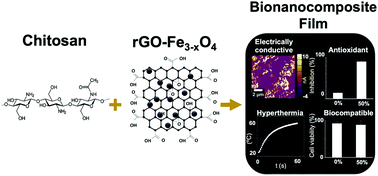Biocompatible chitosan-based composites with properties suitable for hyperthermia therapy†
Abstract
Sustainably made, flexible and biocompatible composites, having environmentally friendly compositions and multifunctional capabilities, are promising materials for several emerging biomedical applications. Here, the development of flexible and multifunctional chitosan-based bionanocomposites with a mixed reduced graphene oxide-iron oxide (rGO-Fe3−xO4) filler is described. The filler is prepared by one-pot synthesis, ensuring good dispersibility of the Fe3−xO4 nanoparticles and rGO within the chitosan matrix during solvent casting. The resulting bionanocomposites present superparamagnetic response at room temperature. The antioxidant activity is 9 times higher than that of pristine chitosan. The mechanical properties of the films can be tuned from elastic (∼8 MPa) chitosan films to stiff (∼285 MPa) bionanocomposite films with 50% filler. The magnetic hyperthermia tests showed a temperature increase of 40 °C in 45 s for the 50% rGO-Fe3−xO4 film. Furthermore, the composites have no cytotoxicity to the nontumorigenic (HaCat) cell line, which confirms their biocompatibility and highlights the potential of these materials for biomedical applications, such as hyperthermia treatments.



 Please wait while we load your content...
Please wait while we load your content...